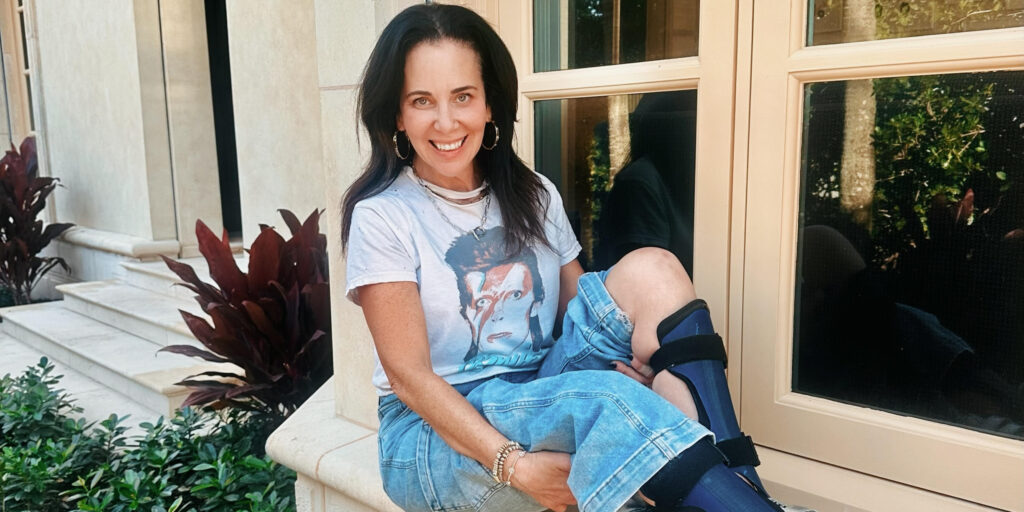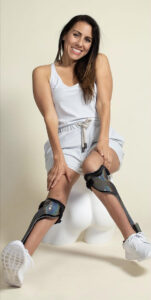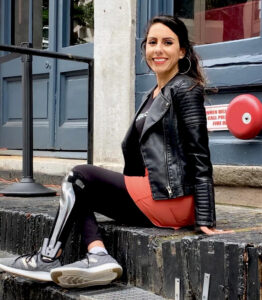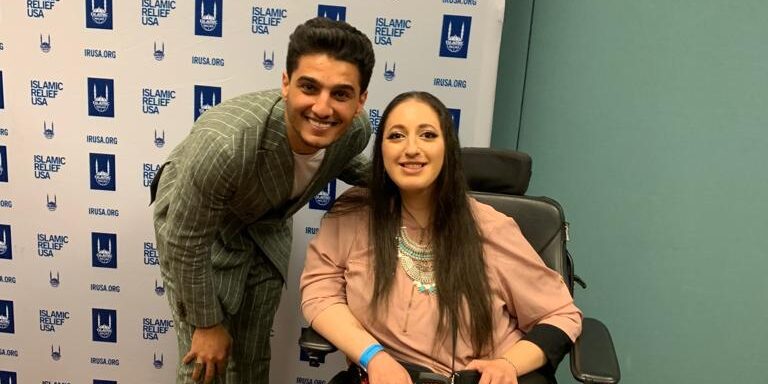
Picking AFO Braces Is Like Buying Jeans: Find Your Perfect Fit
By Estela Lugo | Thursday, January 16, 2025
Choosing an ankle-foot orthosis (AFO) can feel like shopping for jeans — one size does not fit all, and finding the perfect fit often involves trial and error. For those dealing with foot drop, weak ankles, or balance issues due to Charcot-Marie-Tooth disease (CMT) or other neuropathies, the right AFO can provide newfound freedom and mobility. However, challenges such as comfort, aesthetics, and functionality can make the process daunting.

Estela Lugo, who lives with Charcot-Marie-Tooth disease (CMT) shares her insights on choosing AFOs.
This guide combines personal insights and practical advice to help you navigate the world of AFOs. Whether you’re a first-time user or upgrading your current braces, this article will ensure that you’re informed, prepared, and ready to embrace the possibilities.
AFO basics
An AFO is a brace designed to support the foot and ankle, addressing challenges like foot drop, instability, and gait abnormalities. Modern AFOs are available in various styles and materials and can be customized to individual needs.
Common types of AFOs:
- Posterior leaf spring: Flexible and lightweight for mild support.
- Solid ankle: Maximum stability by limiting ankle motion.
- Energy-storing carbon fiber: A spring-like effect for a dynamic gait.
- Articulated or hinged: Adjustable for movement and flexibility.
- Floor reaction: Helps improve balance and lower leg alignment.
For an in-depth look at AFO options and their benefits, visit the Hereditary Neuropathy Foundation’s Bracing Resources.
Find your perfect fit in five steps
1. Understand your needs.
Ask yourself these questions:
- Are you active or stationary?
- Do you need support for daily activities or high-intensity movements?
- What type of shoes do you wear, and will they accommodate an AFO?
2. Consult a professional.
An orthotist is a healthcare professional who evaluates your muscle strength, balance, and gait to recommend the right AFO. Tests may include:
- Dorsiflexion and plantarflexion: Assessing your ability to lift and point your toes.
- Gait analysis: Identifying issues in walking patterns.
- Balance tests: Determining your stability needs.
3. Choose custom or off-the-shelf.
For custom AFOs, the process includes casting, fitting, and adjustments for optimal alignment and comfort.
4. Explore materials and design options.
Some materials allow you to personalize your AFO with colorful covers and designs. Here are the main qualities of common AFO materials:
- Carbon fiber: Lightweight, durable, and great for high activity levels
- Thermoplastics: Fully customizable and long-lasting
- Fabric braces: Flexible and ideal for mild support needs
5. Choose the right brand for you.
Top brands offer innovation, comfort, and style:
- Allard USA: Dynamic options like the BlueROCKER and ToeOFF.
- Ossur: Advanced carbon fiber designs like the AFO Light.
- Turbomed: External braces that fit outside your shoe.
- Kinetic Research: Flexible, customizable braces.
- Ottobock: High-quality materials and advanced technology.
- Helios Bracing: Known for lightweight designs that prioritize comfort and durability.
Style meets function
Finding AFO-friendly clothing, especially jeans, can be tricky, but adaptive fashion is here to help. Pull-on jeans with elastic waistbands or adjustable hems are practical and stylish solutions for brace users.
Trend-Able is a fantastic resource for adaptive fashion tips. Their blog covers everything from AFO-friendly jeans and stylish shoes to accessible accessories and staying fashionable while using mobility aids. Trend-Able ensures you don’t have to sacrifice style for function.
The good, the bad, and the reality
Wearing AFOs takes some adjustment. It helps to understand how they can help you and be aware of issues you might encounter.
AFO benefits:
- Fewer falls and injuries.
- Improved walking efficiency and reduced fatigue.
- Enhanced independence and confidence.
AFO challenges:
- Adjustment takes time and patience.
- Finding compatible shoes can be difficult. Check out BILLY Footwear and Zappos Adaptive.
- Blisters and calluses may appear initially.
Tips for success:
- Be patient — it could take weeks or months to fully adjust to wearing AFOs.
- Incorporate daily stretching to improve mobility and prevent muscle atrophy.
- Ask your orthotist for trial fittings and adjustments to ensure a perfect fit.
- Don’t sacrifice style. Personalized options can make AFOs blend seamlessly into your wardrobe.
Final thoughts: Your Goldilocks moment

AFO-friendly clothing and shoes help Estela express her style.
Finding the right AFO is a journey, but the rewards far outweigh the challenges. With so many options and technological advancements, there’s an AFO for everyone. Be ready to try, adjust, and learn — but also prepare to enjoy the newfound comfort and mobility that an AFO can provide.
If you’re unsure about wearing your AFOs, remember that only the coolest people wear AFOs. Welcome to the club!
For more inspiration on living your best life in AFOs, listen to the EmBrace It Podcast and check out Trend-Able for AFO-friendly fashion tips.
Estela Lugo is Program Development Manager at the Hereditary Neuropathy Foundation and co-host of the EmBrace It Podcast.
Next Steps and Useful Resources
- A fashion blogger with CMT offers tips for looking and feeling your best.
- Learn how CMT affects the legs and feet and how to treat it in CMT and Your Feet.
- Find a neuropathy specialist at an MDA Care Center.
- Stay up-to-date on Quest content! Subscribe to Quest Magazine and Newsletter.
TAGS: Equipment and Assistive Devices, Featured Content, Healthcare
TYPE: Blog Post
Disclaimer: No content on this site should ever be used as a substitute for direct medical advice from your doctor or other qualified clinician.




